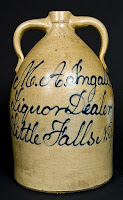In the days before Prohibition, a few whiskey dealers sought to distinguish their spirits by offering them in ceramic jugs decorated with their names written largein cobalt applied letters. Among them was M.A. Ingalls, whose wholesale and retail liquor house was a fixture in Little Falls, New York, for more than a quarter century. Today Ingalls' whiskey jugs, initially given away, can command prices of up to $1,000 or more.
Although the company letterhead indicates a founding date of 1877 the first Little Falls directory reference to Ingalls’ liquor house that I can find is 1893, located at 311 South Second Street. The proprietor’s first efforts at obtaining whiskey jugs with his name emblazoned on them may not have been completely successful. Below are two early efforts from Ingalls that are crudely done. The one at left has blobs of cobalt and a distinctly amateurish look. The larger jug at right indicates an effort to correct an earlier spelling error by writing over an errant “g” to form the Ingalls name.
Those errors seemed to end when Ingalls discovered the potteries of Ft. Edward, New York, about 90 miles northeast of Little Falls. That town along the Hudson River had become renowned for its production of stoneware. Beginning in the 1850s several local companies produced a unique type of pottery featuring cobalt-applied lettering or designs on an off-white or brown-glazed body. Ingalls had found the perfect containers for his whiskey.
Of the several potteries in Ft. Edward, Ingalls seemed to favor the craftsmanship of the Ottman brothers, who operated a pottery from 1872 to 1892. Their company became known for the bright, shiny quality of its cobalt lettering, applied by skilled decorators. Shown above are two examples of the the Ottman artistry, each holding three gallons of whiskey. Below are two smaller containers from the Ingalls liquor house, likely created by a different New York potteries. The jug at right is particularly interesting in that it is not written in cursive script but in print type letters, a somewhat unusual format for whiskey containers of this type.
When the Ingalls jugs reached five gallon size, they were adapted to a two-handle format. This made them easier to carry and able to be decanted by wholesale customers into smaller size containers. The jug at left sold at auction in 2020 for just under $1,000, indicating the collector market for these pre-Prohibition vessels, all of which have attained “antique” status. The jug identifies nearby “Herkimer” as the locality rather than Little Falls, which is in Herkimer County.

The final two five gallon examples from the Little Falls liquor house have a slightly darker outer glaze, indicating to me that they were made in a different, unidentified pottery. Like others here their contents likely were received by the barrel from Massachusetts and nearby states, coming by rail, and then either “rectified” by the company or poured unblended into the containers exhibited here, then sold at both wholesale and retail.
 Personal details about M.A. Ingalls are hard to come by. He appears to have avoided the 10-year census throughout his life. More is known about his older brother, John W. Ingalls, who was involved in the whiskey trade in collaboration his sibling. John was wed to Mary A. in 1865 and the couple appears to have had one child, Daniel, born late in their marriage. M.E. Ingalls may not have married. Both brothers lived at 580 Garden Street, the house shown here as it looks today..
Personal details about M.A. Ingalls are hard to come by. He appears to have avoided the 10-year census throughout his life. More is known about his older brother, John W. Ingalls, who was involved in the whiskey trade in collaboration his sibling. John was wed to Mary A. in 1865 and the couple appears to have had one child, Daniel, born late in their marriage. M.E. Ingalls may not have married. Both brothers lived at 580 Garden Street, the house shown here as it looks today..
In the meantime, because each of them is a singularity given of the nature of its crafting, the value of these whiskey jugs is sure to increase with the passing years. Whether he anticipated it or not, M.E. Ingells left later generations a heritage in cobalt.
Notes: Although Ingalls whiskey jugs are frequently featured on auction and sales sites, the company and its personnel largely have “flown under the radar.”. I am hopeful that sharp-eyed descendants of the Ingells brothers will see this post and help fill in the blank spots.











No comments:
Post a Comment